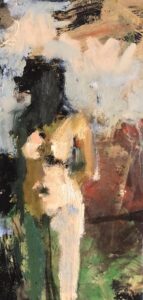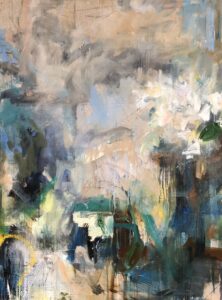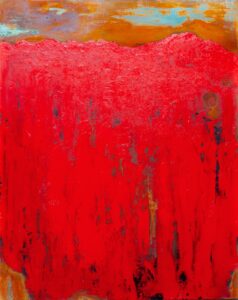Paintings that Abstract and Reveal
As her career has matured, Cynthia Packard’s paintings of human figures, flowers, dogs, and boats have become increasingly abstracted. She’s still rooted in painting from observation, but the subjects of her work are more obscured. Her art is about searching, and the viewer must join the search. “I’m really interested in letting viewers complete the painting,” she says.

“Reveal,” an exhibition featuring new and older work by Packard, is on view at the gallery on the main campus of Truro Center for the Arts at Castle Hill (8 Meetinghouse Road), with an opening reception on Thursday, Aug. 14 at 4 p.m.
In Arrangement, Packard paints a bouquet of white flowers. But they’re obscured and not central to the composition. Instead, one feels the light, airy promise of the flowers in the washy marks of pale colors at the center of the composition. Darker colors and heavier marks at the bottom of the picture contribute to the lift of the painting as the eye — and spirit — of the viewer is drawn upward.

Packard’s cavernous studio in Provincetown is filled with canvases of all sizes. Her exhibition at Castle Hill features modestly scaled work, with some larger pieces reserved for an exhibition at the Packard Gallery (418 Commercial St.) opening on Friday, Aug. 15. Whether working large or small, Packard is always in search of the spontaneous mark and direct expression. “I want my paintings to look like I just began and to tell the truth in the moment,” she says.
The show is on view until Aug. 29. See castlehill.org. —Abraham Storer
Staying Afloat With Flotilla DeBarge
Known for her live vocals and sharp comic timing, Flotilla DeBarge’s cabaret shows have been among New York City’s hottest tickets for decades. As former Village Voice columnist Michael Musto noted, “Flotilla is a great singer and comic who takes her audiences on a fabulously fun journey,” while actor, playwright, and fellow drag legend Charles Busch called her “outrageous, over the top and blisteringly intelligent.”

DeBarge is bringing her new “Concepts of a Show” to Red Room this week for two performances on Friday, Aug. 15 and Sunday, Aug. 17.
Once a struggling actor and singer, DeBarge was inspired to start performing in drag after watching John Waters’s 1974 camp classic Female Trouble. “I realized I could pull from acting, singing, and drag to create a persona,” she says — quickly adding that while there is some overlap between the two, her drag persona and her offstage identity are kept quite separate.
DeBarge has had her share of euphoric highs and devastating lows. “The show will reflect my journey to this moment,” she says. (No spoilers, but on the list of drag queens whose life stories should be adapted into movies, DeBarge’s name should be on top.)
A decades-long veteran of the New York City drag scene and the 2002 Bistro Award winner for “Consummate Drag Artistry,” DeBarge credits her longevity to discipline and old-school stagecraft. “A career in New York takes more than talent,” she says. She’s grateful for early mentors like Lady Bunny and Joey Arias who guided her through the growing pains of her early years in drag. “I thank the universe for every time I fell and got back up,” she says.
In addition to roles in feature films like To Wong Foo… and Flawless, DeBarge has appeared in TV’s Law & Order and enjoyed a stint on Broadway in a 2006 revival of Bertolt Brecht’s The Threepenny Opera. She thought she’d blown her audition for HBO’s 2003 production of Tony Kushner’s Angels in America by telling director Mike Nichols she needed to know immediately whether she was being cast or not because she had tickets to see what was then being billed as Cher’s farewell concert. (Luckily, Nichols gave her the part, and Cher never retired anyway.)
While her current show includes measured amounts of political commentary, she encourages audiences to learn their own queer history. “They are erasing us,” she warns. “Learn your history now before these things are gone.”
And while she’s frequently called a “legend,” DeBarge resists the title, especially when she hears it from younger queens. “I’m still in the game,” she says.
Tickets are $41.50-$51.50 at redroom.club. —James Judd
A Show for the End of the World
Pay special attention to the title of Dan Kitrosser’s one-man show, Homos! A Solo Disaster Musical, bitch. The punctuation is important, says Kitrosser — it makes it clear that “you are the bitch.” He calls the show “an impossible cabaret”: “It’s me trying to put on a full-scale musical with a couple of wigs and a dream.”

Kitrosser says he thought up the project a decade ago while studying for his M.F.A. at the New School for Drama in New York City. “We were tasked with writing four short plays that followed characters over the course of a year,” he says. “I thought it would be interesting if the year I charted was the last year of the world.”
Homos! is a take on Hollywood disaster movies, Kitrosser says. His six queer protagonists range from a Norma Desmond-like character nostalgic for stardom to “a twink having an existential crisis when he realizes the only thing left after the world ends will be the images he saved to the cloud.” Each character has a song, and each of those songs is a pastiche of a different musical style, including vaudeville, big band, and old-time Broadway. “I get to explore queerness and the apocalypse through music,” Kitrosser says. “How fun!”
“This show is not for kids,” he adds. “But I like to say that my theater is children’s theater for adults. It’s about dressing up. It’s about play.” Kitrosser loves wigs, and he loves playing different characters. “I also know everyone else loves that shit, too,” he says. “We were told at a certain point that it wasn’t cool anymore, and that we had to grow up.” He thinks of his show as an antidote to that feeling: “For one precious hour, let’s be morons.”
Homos! is at Red Room (258 Commercial St, Provincetown) on Thursday, Aug. 14, at 5:30 p.m. Tickets are $41.50-$51.50 at redroom.club. —Eve Samaha
Sculpting True Stories in Sound
Radio producer and reporter Joe Richman calls himself “an evangelist for sound,” particularly for audio storytelling: “Hearing is an incredibly evocative and powerful sense,” he says. In 1996, Richman founded the New York City-based nonprofit Radio Diaries, which provides people of all ages and professions around the world with tape recorders so that they can report on their own lives.

On Saturday, Aug. 16 at 7 p.m., Richman will discuss and present excerpts from the Radio Diaries project at Wellfleet Preservation Hall (335 Main St). “There are funny, extroverted storytellers, and there are quiet, intimate storytellers,” Richman says. What’s most important in any story, though, are the characters. Radio Diaries, which broadcasts its 15-to-30-minute stories on NPR’s All Things Considered, international radio stations, and on its dedicated podcast, has featured the voices of participants ranging from a young woman with AIDS in South Africa to a teenage Mexican immigrant in Texas.
These storytellers often spend months with their tape recorders and usually record up to 40 or 50 hours of tape. Part of Richman’s job is editing the material into a short documentary. “It’s less like producing and more like sculpture,” he says. “You have this big slab of stone, and you’re chiseling away all the things that don’t belong until you can see the story there. One thing audio storytelling does better than any other medium is to connect us to the story and the people. You’re not hearing from a reporter and a host; you’re hearing directly from the characters in the story. By doing that, hopefully you feel a deeper connection.”
Richman adds that the theme of the event at Preservation Hall is “the role of storytelling in an age of mistrust.” With journalism and truth currently under attack, he says, “stories that can get at an emotional truth have the potential to bridge divides and create a sense of trust.”
Tickets are $25 plus fees at wellfleetpreservationhall.org. —Eve Samaha
Theater That Evokes Queer Resistance
Founded in 1989 during the AIDS crisis, the Theater Offensive has always used theater as a vehicle for queer resistance and cultural survival. In 2019, its mission was revised to focus on the art of queer and trans Black and Indigenous people. Giselle Byrd, the company’s executive director since 2023, is the first Black trans woman to lead a regional theater company in the U.S. – a milestone at a moment when the rights, health, and existence of trans people are under attack.

That urgency animates the Theater Offensive’s event on Friday, Aug. 15 at the Commons (40 Bradford St., Provincetown) spotlighting three artists whose work embodies what’s at stake today and what liberation can look like: poet and playwright Letta Neely, spoken word artist and theater maker Amanda Shea, and drag performer Neon Calypso.
It will be the first time since 2014 that the group is performing in Provincetown. (Each summer from 1996 to 1999, the group staged a weekly guerrilla production called A Street Theater Named Desire at Herring Cove Beach to promote safer sex.) But in the spirit of Sunset Boulevard’s Norma Desmond, “We don’t call it a comeback — it’s a return!” says Byrd.
A panel discussion with Byrd and the three performers will explore how artists continue to create in a politically hostile environment and how they face challenges ranging from cuts in government funding to the erasure of trans lives in policy and culture. The Theater Offensive is currently a co-plaintiff in an ACLU-led suit against discriminatory NEA funding practices. “We can’t afford to be silent,” Byrd says. “And we can’t afford to be complacent.”
With its focus on solo performers and minimal setup, the event harkens back to the group’s origins in guerrilla theater. “We need to be out in these streets as much as we are in the Black Box,” Byrd says. But while its name evokes a spirit of confrontation, that militancy exists in dialogue with something just as radical: a commitment to care and inclusion.
Tickets begin at $40. See thetheateroffensive.org. —Brian Droitcour
Willie Little Reflects on Home
For years, multidisciplinary artist Willie Little has been exploring the meaning and memories of home through his work. He has created installations that replicate his childhood bedroom, ceramic sculptures representing the shacks his father built, and paintings in which color and surface textures recall the decaying buildings that Little saw while growing up in rural North Carolina.

His new work, on view at Rice Polak Gallery (430 Commercial St., Provincetown), is titled “When I Think of Home,” inspired by the song “Home” from the musical The Wiz. In this series, Little, who works in Portland, Ore. and Palm Springs, Calif., continues to mine memories of his childhood home. This time, he approaches those memories with elation.
For Little, colors are exaggerated in a child’s memory. Rusty Pane Horizon features the brilliant orange of the sun. In A Bountiful Harvest, he uses a bright aqua-green inspired by the vibrant hues he remembers from his grandmother’s garden.
The innocence of these color choices is juxtaposed with the rough texture of the paintings that comes from repeated layering and scraping of their surfaces. The works speak to decay but also beauty; the innocence of childhood, but also the inevitable end of that innocence.
The colors are also a result of Little’s process, which involves mixing oil paint and wax with various chemicals to create oxidation reactions. The colors become more vibrant, as with the richly textured and pulsating red that covers most of the surface of Red Desert Canyon. Aqua, deep purple, and copper tones show through, creating depth and vibration between the colors.

Each image creates a mood or feeling that, for Little, is deeply personal and rooted in his upbringing. The power of these paintings, however, lies not just in the personal story they tell for the artist but in the feelings and memories they can evoke in the viewer. The chunky layers of orange, thin stripes of green, and large swaths of pale blue of In a Lime Green Haze could easily be interpreted as a landscape, perhaps a view over the bay with fog below and sun above, or a depiction of that odd green light that happens before a summer storm. With each composition, Little sets the stage for the viewer and invites us to revisit our own color-driven memories.

The show is on view until Aug. 27. See ricepolakgallery.com. —Antonia DaSilva



